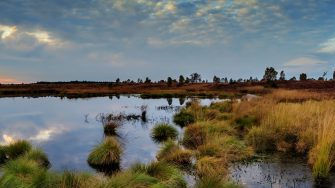
Date: Wednesday, October 6, 2021
Project: Eastern Australian Waterbird Survey
Observers: Richard Kingsford & John Porter
Pilot: James Barkell
This is our 39th aerial survey of waterbirds across eastern Australia and very much like last year in many ways, COVID restrictions are very challenging. Normally, we would fly up the coast to begin our surveys in Queensland. But obviously this is not happening – yet - hopefully. So instead we are working our way across NSW and parts of Queensland and Victoria where we can fly and survey wetlands and waterbirds but not land in those states. We at least have approval to survey wetlands in New South Wales and also Victoria which covers most of the Murray-Darling Basin wetlands.
We set off from Sydney watching the sun rise over the ocean on Palm Beach in northern Sydney.
We had to refuel at Armidale. With a full load of fuel we headed north up to survey band 6 (each survey band is 30km wide and we survey wetlands and rivers in this area, east to west). This survey band is just over the border in QLD. We then set about surveying the most easterly large dam in this survey band, Coolmunda Dam.
The dam was full but did have as many waterbirds as in the dry years when it's a major refuge, but there were flocks of grey teal and the different cormorant species.
Then we criss-crossed west along the survey band and the floodplains of the Macintyre and Weir Rivers. Here many of the original floodplains have been radically changed with irrigation building levee banks and channels crisscrossing the floodplain and stopping the natural flows of the rivers. There are relatively few natural wetlands in this system anymore. Interestingly where there were some natural wetlands, there were lots of waterbirds with a high diversity. It just shows what a magnificent river system this once was. Most of our surveys these days involve going back and forth across large irrigation dams which are much too deep to support many waterbirds, despite their large size.
Along the way there are also a few natural waterholes, like Boobera Lagoon, a particularly culturally important place. These waterholes hold water even in dry times. But when there is lots of other water around in remaining natural wetlands, such waterholes don’t support many waterbirds. There was hardly anything on the lagoon.
There were many large off river storages along the Border Rivers which we surveyed. We then flew across to the Condamine-Balonne River system where many of the off river storages had water. Earlier in the year there had been extensive floods through this system. As we got further south, many of the large storages were dry around Dirranbandi. But there was good evidence of an excellent cotton crop from the floods earlier in the year with rows of cotton bales covered by pink, blue and yellow and stacked next to each other. In 2021, cotton bales were worth up to $550 each.
Our last place to survey was south of survey band 6. We headed for one of the more important wetlands in the Murray-Darling Basin. The Narran Lakes Nature Reserve supports a large floodplain and lake systems, which can support large numbers of waterbirds. In the past this included hundreds of thousands of colonially breeding waterbirds such as straw-necked ibis.
The development of irrigation upstream has reduced the frequency of flooding significantly and the importance of this place for waterbirds and other species. And when we surveyed the wetland today, there was hardly any water left in this system.
There were also relatively few waterbirds on the remaining patches of water, mainly red-necked avocets, glossy Ibis, grey teal and yellow-billed spoonbills.
It is some time since we have surveyed this system with water and it was surprising to see vegetation, probably river cooba bushes growing in the middle of Clear Lake. It probably signifies the changing and transitioning of the lake which holds water frequently, to a wetland which supports vegetation which does not flood as frequently. Today, there were a few remaining channels with water and Clear Lake was extremely shallow.
